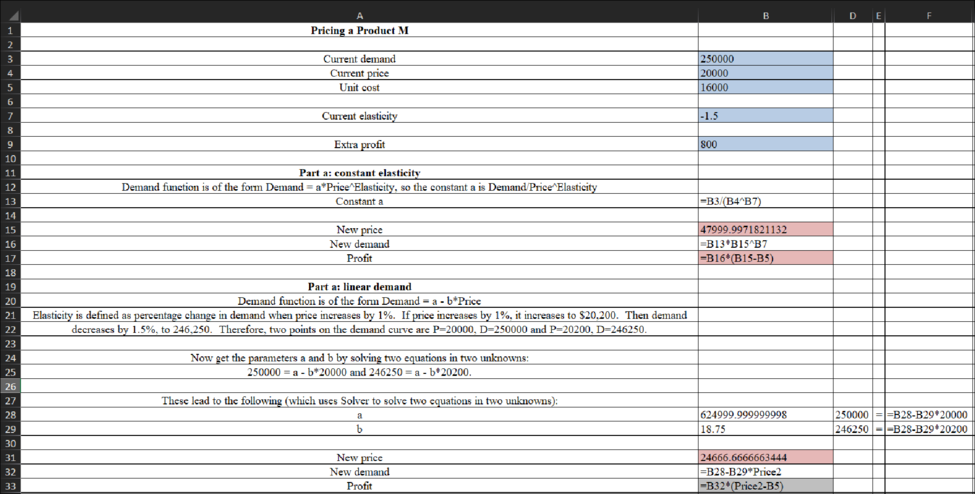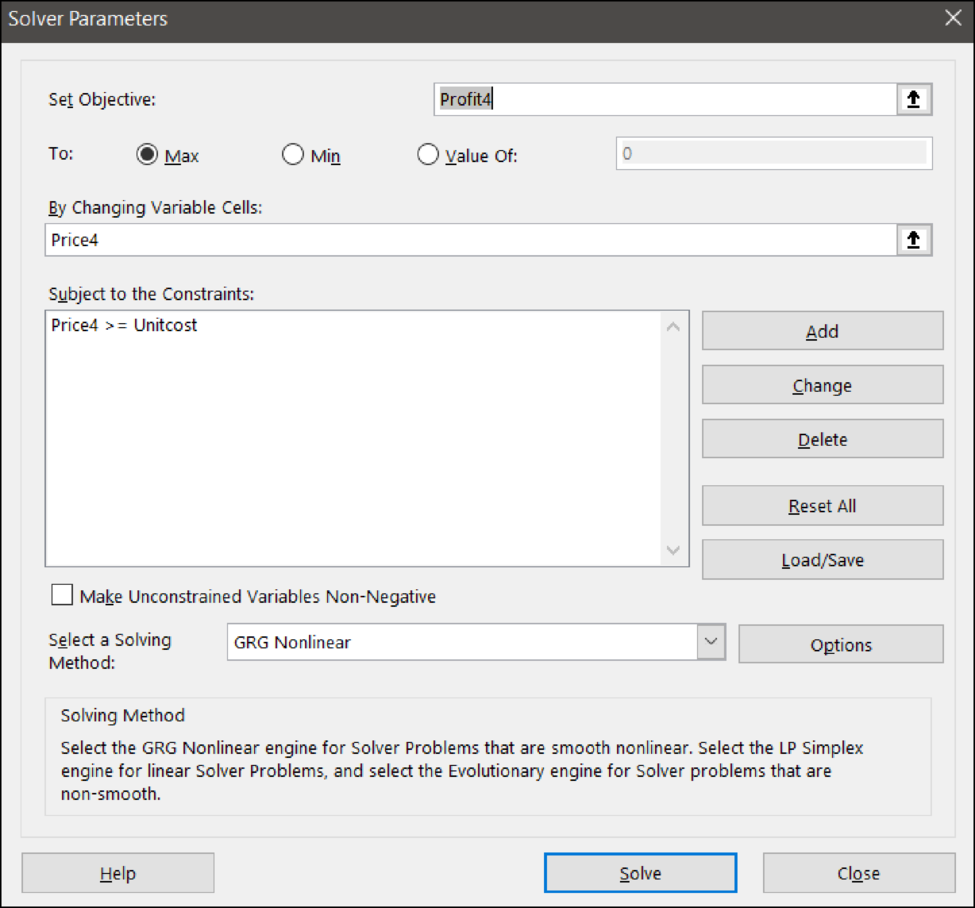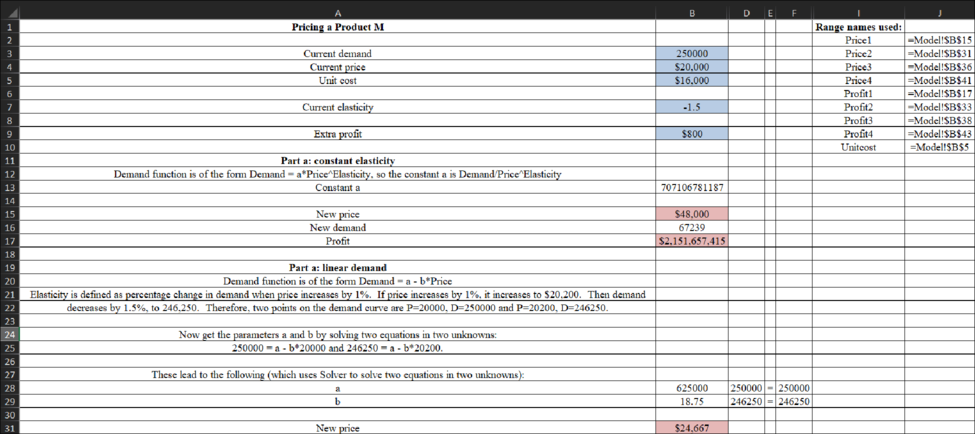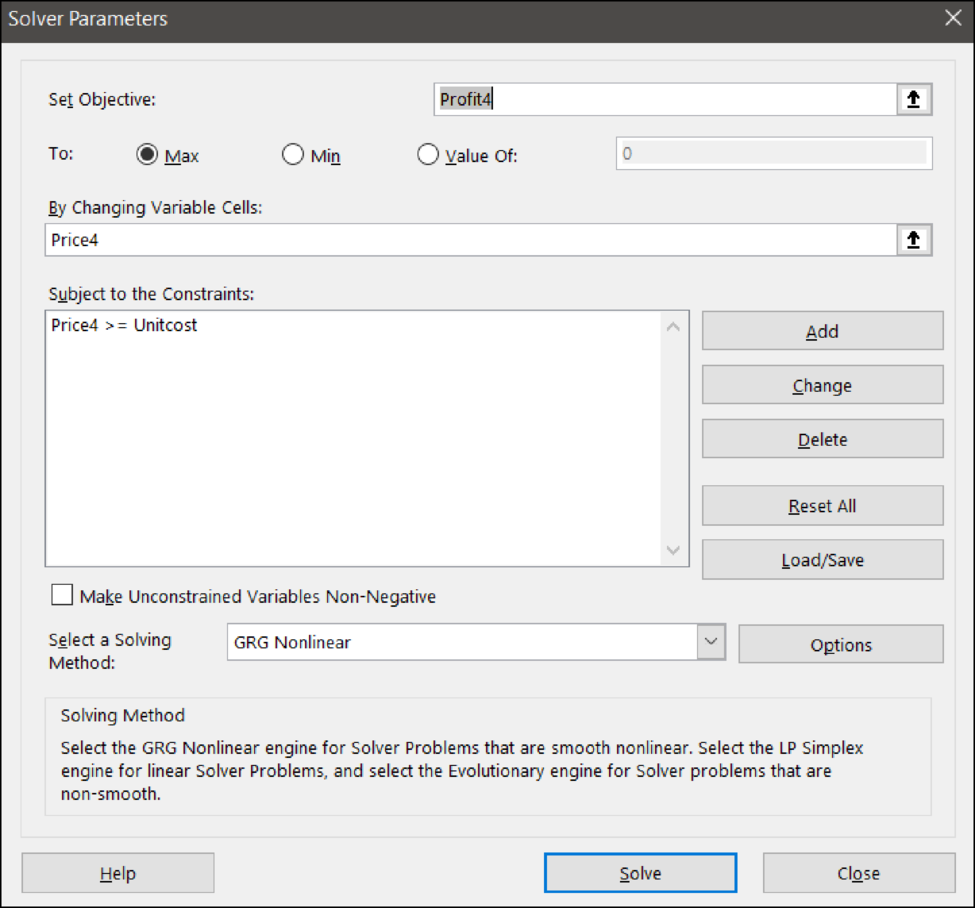
Practical Management Science
6th Edition
ISBN: 9781337671989
Author: WINSTON
Publisher: Cengage
expand_more
expand_more
format_list_bulleted
Concept explainers
Question
Chapter 7, Problem 45P
a)
Summary Introduction
To determine: The profit-maximizing price of Product M when the demand function is constant elasticity and also linear.
Non-linear programming (NLP):
Non-linear programming (NLP) is used in complex optimization problems where the objectives or constraints or sometimes both are non-linear functions of the decision variables. A model can be termed as non-linear for more than one reason.
a)
Expert Solution
Explanation of Solution
Model

Formula:

Solver input:

b)
Summary Introduction
To determine: The profit-maximizing price of Product M when the demand function is constant elasticity and also linear for an additional profit of $800.
b)
Expert Solution
Explanation of Solution
Model


Formula:


Solver input:

Want to see more full solutions like this?
Subscribe now to access step-by-step solutions to millions of textbook problems written by subject matter experts!
Students have asked these similar questions
Discuss your understanding of job vs. person pay for performance structures. Which structure do you believe has the greatest impact on compensation decisions? no Ai please
Discuss how the article aligns with the concept:
1. The development of Legislative Health Policy
2. The Role of research in policy development
Discuss how the article aligns with the concept:
1. The development of Legislative Health Policy
2. The Role of research in policy development
Chapter 7 Solutions
Practical Management Science
Ch. 7.3 - Prob. 1PCh. 7.3 - Prob. 2PCh. 7.3 - Pricing Decisions at Madison The Madison Company...Ch. 7.3 - Prob. 4PCh. 7.3 - Prob. 5PCh. 7.3 - Prob. 6PCh. 7.3 - Prob. 7PCh. 7.3 - Prob. 8PCh. 7.3 - Prob. 9PCh. 7.3 - Prob. 10P
Ch. 7.3 - Prob. 11PCh. 7.3 - Prob. 12PCh. 7.3 - Prob. 13PCh. 7.3 - PRICING SUITS AT SULLIVANS Sullivans is a retailer...Ch. 7.3 - Prob. 15PCh. 7.4 - Prob. 16PCh. 7.4 - Prob. 17PCh. 7.4 - Prob. 18PCh. 7.4 - Prob. 19PCh. 7.4 - Prob. 20PCh. 7.4 - Prob. 21PCh. 7.4 - Prob. 22PCh. 7.4 - Prob. 23PCh. 7.5 - Prob. 24PCh. 7.5 - Prob. 25PCh. 7.5 - Prob. 26PCh. 7.5 - Prob. 27PCh. 7.6 - Prob. 28PCh. 7.6 - Prob. 29PCh. 7.6 - Prob. 30PCh. 7.6 - Prob. 31PCh. 7.6 - Prob. 32PCh. 7.6 - Prob. 33PCh. 7.6 - The method for rating teams in Example 7.8 is...Ch. 7.7 - Prob. 35PCh. 7.7 - Prob. 36PCh. 7.7 - Prob. 37PCh. 7.7 - The stocks in Example 7.9 are all positively...Ch. 7.7 - Prob. 39PCh. 7.7 - Prob. 40PCh. 7.7 - Prob. 41PCh. 7.7 - Prob. 42PCh. 7.8 - Given the data in the file Stock Beta.xlsx,...Ch. 7.8 - Prob. 44PCh. 7 - Prob. 45PCh. 7 - Prob. 46PCh. 7 - Another way to derive a demand function is to...Ch. 7 - Prob. 48PCh. 7 - If a monopolist produces q units, she can charge...Ch. 7 - Prob. 50PCh. 7 - Prob. 51PCh. 7 - Prob. 52PCh. 7 - Prob. 53PCh. 7 - Prob. 54PCh. 7 - Prob. 55PCh. 7 - Prob. 56PCh. 7 - A beer company has divided Bloomington into two...Ch. 7 - Prob. 58PCh. 7 - Prob. 59PCh. 7 - Prob. 60PCh. 7 - Prob. 61PCh. 7 - Prob. 62PCh. 7 - Prob. 63PCh. 7 - You have 50,000 to invest in three stocks. Let Ri...Ch. 7 - Prob. 65PCh. 7 - Prob. 66PCh. 7 - Prob. 67PCh. 7 - Prob. 68PCh. 7 - Prob. 69PCh. 7 - Prob. 70PCh. 7 - Based on Grossman and Hart (1983). A salesperson...Ch. 7 - Prob. 73PCh. 7 - Prob. 74PCh. 7 - Prob. 75PCh. 7 - Prob. 76PCh. 7 - Prob. 77PCh. 7 - Prob. 78PCh. 7 - Prob. 79PCh. 7 - Prob. 80PCh. 7 - Prob. 81PCh. 7 - Prob. 82PCh. 7 - Prob. 83PCh. 7 - Prob. 84PCh. 7 - Prob. 85PCh. 7 - Prob. 86PCh. 7 - Prob. 1.1CCh. 7 - Prob. 1.2CCh. 7 - Prob. 1.3CCh. 7 - Prob. 1.4C
Knowledge Booster
Learn more about
Need a deep-dive on the concept behind this application? Look no further. Learn more about this topic, operations-management and related others by exploring similar questions and additional content below.Similar questions
- Mcq question need ans.arrow_forwardSay women on average take twice as long in the restroom (not including waiting times) than men. Is the 2:1 ration for flushing capacity the right ratio?arrow_forwardTo what extent does the equation for the waiting time in the queue help explain why queues for the Women's room might be longer than queues for the Men's room before 2005 in New York City?arrow_forward
- Besides adding flushing capacity for the women's bathrooms versus men's bathrooms, what can be done to reduce waiting time for the restrooms?arrow_forwardHow does rework hurt a process? Give examples on how rework can hurt a process. Please provide a referencearrow_forwardHow does rework hurt a process? Give examples on how rework can hurt a process. Please provide a referencearrow_forward
- What the different between a near miss and hazard 1. movement and contact 2. Contact 3. movementarrow_forwardThe fixed and variable costs for three potential manufacturing plant sites for a rattan chair weaver are shown: Site Fixed Cost Per Year Variable Cost per Unit 1 $700 $12.00 2 $1,000 $7.00 $2,200 $5.00 a) After rounding to the nearest whole number, site 1 is best below After rounding to the nearest whole number, site 2 is best between After rounding to the nearest whole number, site 3 is best above b) If the demand is 590 units, then the best location for the potent 3 units. and units. 600 0 60 units. g plant isarrow_forwardRefer to Table S6.1 - Factors for Computing Control Chart Limits (3 sigma) for this problem. Sampling 4 pieces of precision-cut wire (to be used in computer assembly) every hour for the past 24 hours has produced the following results: Hour R Hour X R Hour X R Hour X R 1 3.25" 0.71" 7 3.15" 0.58" 13 3.11" 0.85" 19 4.51" 1.56" 2 3.20 1.18 8 2.65 1.08 14 2.83 1.31 20 2.79 1.14 3 3.12 1.38 9 15 4. 3.39 1.31 10 5 2.97 1.17 6 2.76 0.32 3.02 0.71 3.12 1.01 2.75 1.33 16 2.74 0.50 22 11 2.73 1.17 17 2.76 1.43 23 12 2.87 0.45 18 2.64 1.24 21 2.75 1.03 3.18 0.46 2.94 1.53 24 2.54 0.97 Based on the sampling done, the control limits for 3-sigma x chart are (round all intermediate calculations to three decimal places before proceeding with further calculations): Upper Control Limit (UCL) = inches (round your response to three decimal places). Lower Control Limit (LCL) = inches (round your response to three decimal places). Based on the x-chart, the wire cutting process has been The control limits…arrow_forward
- Choose a specific cars company. E.g Toyota, Volkswagen, Hyundai, Mercedes-Benz, BMW, Honda, Ford, Audi, Tesla Define a list of required machinery, equipment, workstations, offices, rest areas, materials, etc. Develop and define the location of machinery, equipment, workstations, offices, rest areas, materials. Make the distribution in the manufacturing facility the most efficient way possible. Develop a process distribution for one specific product. Explain why you consider this is the most efficient distribution for this specific manufacturing facility. demonstrate the benefits of optimizing a production line with the best distribution of its equipment and spaces. To be more productive and profitable.arrow_forwardProvide a Synposis of the Articlearrow_forwardThe goal of understanding personality in negotiation is to better predict behavior, such as the counterparty's acceptance or rejection of a negotiation offer. One investigation used acoustic and visual cues to predict the likely behavior of a counterparty to a proposal. The best visual cue predictor of the counterparty (55%) was whether they _____. A. tilted their head B. had their arms and legs crossed C. steepled their fingers D. tapped a penarrow_forward
arrow_back_ios
SEE MORE QUESTIONS
arrow_forward_ios
Recommended textbooks for you
 Practical Management ScienceOperations ManagementISBN:9781337406659Author:WINSTON, Wayne L.Publisher:Cengage,
Practical Management ScienceOperations ManagementISBN:9781337406659Author:WINSTON, Wayne L.Publisher:Cengage,

Practical Management Science
Operations Management
ISBN:9781337406659
Author:WINSTON, Wayne L.
Publisher:Cengage,